Virtual Art House open for public June 2025
Extra Live goes live during June 2025
VAH
Virtual Art House (VAH) is a multi-user socialVR platform and digital twin of the Art House Turku culture center, created in collaboration with Proverse.
This virtual cultural center hosts events and exhibitions with a biannual program. User-generated content will be available later through community spaces in our skyscraper, also known as the ”Infinite Culture Tower.”
Further expansions and collaborations are possible, offering high-level customization and facilitation at various scales, from individual needs to MaaS. Read more at the end of this page!
CULTURHUB
CULTURHUB is an international community platform established in May 2024. It connects individual culture professionals, tech developers, academics, and organization representatives. Together, we are passionate about exploring the possibilities of art and culture in the digital era. The community is an integral part of the VAH platform, enabling direct access to collaboration, co-creation, and virtual residency programs. The community is open to new partners at any time. For more information and member application instructions, visit the CULTURHUB webpage.
Extra Live
Extra Live is a global event featuring artists and collaborators from around the world, spanning all continents except Antarctica. The first edition of the VAH program celebrates the concurrent opening of the VAH platform. CULTURHUB community professionals created this event as a joint world-building process through a virtual residency during early 2025.
The Extra Live event begins expanding on during June 2025, with sub-events running until December 31, 2025. It is available in VR and on PC, with mobile availability planned for the future.
EVENT STARTS EXPANDING IN JUNE 2025 AND WILL BE CLOSED 31.12. 2025 Available on WebVR / VR / (MOBILE later)
Curated by Rebeka Kovacs, Yev Kravt, Laura Reséndiz, Shashank Satish & Virpi Vaittinen
Artists: Adonis Archontides / Aki Silventoinen / Alex Valentina / Ambulance (Kaisa Penttilä, Reetta Neittaanmäki) / Benjamin Pompe / Carmilla Sumantry / Christelle Mas / Fabianna de Barros / Faysal Mrouehs / Gohar Martirosyan / Eko Saputra / Elina Ruohonen / Eva Papamargariti / FlyAR & Sheikki / Harshit Agrawal / Hui Zhang & Zoey Zhao / HYENAZ (Adrienne Teicher & Kathryn Fischer) / Jamie McGhee / Jinn Laun (aka Beh Chin) / Jonas Lund / Jouna Karsi / Jukka Hakanen / Kathryn Carter / Kévin Bray / Leena Jääskeläinen / Lilli Haapala / Linda Young (Yellow Wasabi) / Lotta Leka / Maciej Tomaszewski & Eero Tiainen / Maria Touloupou / Maria Nurmela & Vesa Loikas / Marie Samuel Levasseur / Michalis Charalambous / Mike Pelletier / Sini-Meri Hedberg / Mica Cabildo & Curtis Cresswell / Natasha Singh / Ollipekka Kangas / Paul Wiersbinski / Paulo Majano / Perttu Pölönen / Raiël Solomon / Robert Lisek / Roberto Santaquida / Roope Rainisto / Seamy Side Quest (Iida Pitkänen, Jenni Kemppainen) / Sahil Betigeri / Shashank Satish / Simone Martinotta / Toni Hautamäki / Yogesh Ramkrishna / YOU?
Concept & Coordination by Ville Laaksonen
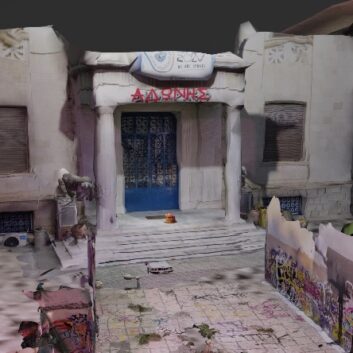
Adonis Archontides:
Doppelgänger
Three large-scale 3D installations composed of digital scans of real exhibition spaces: The Island Club in Limassol (Cyprus), Sylvia Kouvali’s gallery in Piraeus (Greece), and LUMA Arles’ East Gallery (France). Spaces the artist once knew only as a collaborator and visitor, now reimagined as virtual stages for his own interventions. Who holds agency once a space has been scanned and doubled? The institution? The artist?
Informed by his mythological namesake, Archontides considers the artist a Campbellian Hero, one who constructs their own narrative through acts of transformation and self-authorship.
In each environment, autobiographical residues surface, flowers, cats (abundant and neglected in Cyprus), household objects, fragments of past shows, personal memories, and videogame photography. Across the three segments, Archontides explores strategies of layering and visibility within environments that flicker between the real and the unreal, the lived and the simulated, often using the glitch as a formal rupture that opens space for absurdity, fragility, or unintended clarity. This culminates in Studies on Breaking Immersion, a series made entirely within video games that feature embedded photography tools, documenting a visual artifact known as z-fighting, where two or more objects occupying the same space compete for visibility.
Adonis Archontides, a multidisciplinary artist from Cyprus, moves between satire and introspection. His work explores how identity is constructed, consciously and unconsciously, and plays with the porous boundaries between reality, fiction, simulation, and dream, often returning to themes of beauty and decay, glitch and perfection, recollection and imagination.
Technical Information: 3D scans captured in Polycam and Shining 3D EinScan-SE, rendered in Unity.
Instagram: @ragnanox
Adonis Archontides is part of the group exhibition Doppelgänger, curated by Yev Kravt.
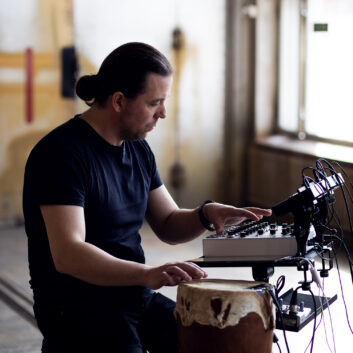
Aki Silventoinen:
Extra Live with Silven2
Electronic music composer Aki Silventoinen a.k.a ”Silven2.” performs live and creates improvised synthesizer music on the fly. The music shows will be streamed live on specific dates.
(Five live electronic music gigs, cinematic textures, out-of-this-world sound design.)
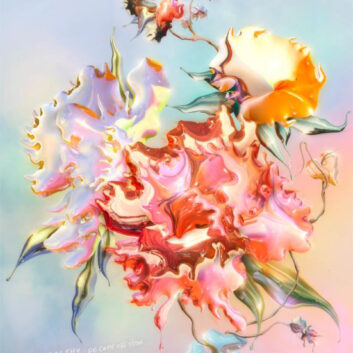
Alex Velentina:
Doppelgänger: Digital Garden
Drenched peonies, glistening with nectar-like droplets. Two butterflies, synthetic, hover above, their wings too smooth, too curved, too perfect to be real. Alex Valentina plays with the notion of hyperrealism. In this hybrid world, nature doesn’t wilt; it is rendered, replicated, and pushed to the edge of recognition.
Valentina works at the threshold between the organic and the artificial, crafting natural simulations so heightened they begin to unravel. His images seduce, because they teeter on the edge of believability. “I bring reality to the point that it becomes less real,” he explains. “Perfection is the enemy of good.”
The synthetic garden becomes a mirror. For Valentina, the double is a condition of being human. How many versions of ourselves exist at the same time? And more crucially: the version we think we see is almost never the one others see.
He describes his work as “a little crush”, something that surprises, seduces, but never fully resolves. Simulation, for him, is both a comfort and a warning. There is a thrill in the artificial, a seduction in the surface. But the senses crave something more. “Every time I feel something powerful, something that wakes me up,” he says, “it’s always smells or sights from the real world. What is alive and real is ten thousand times stronger than the simulation.”
A lover of detail and HDness, Valentina recalls us of what we forget. “I read an article that said the thing astronauts miss the most after six months on the space station is the wind, the feeling of air on their skin, the smell of rain. That says a lot about what our true priorities are.”
Alex Valentina is a visual artist and designer whose work bridges nature and creativity, blending the physical with the digital. His practice combines 3D art with real photography, creating a universe of liquid synaesthesias and enchanting creatures. Now based in Milan, Valentina explores the expressive possibilities of both fantasy and physical elements, likening this creative process to unleashing a superpower.
The work: They’re appearing to me as I appear to them.
Instagram: @alexvxvxvxvx
Alex Valentina is part of the group exhibition Doppelgänger, curated by Yev Kravt.
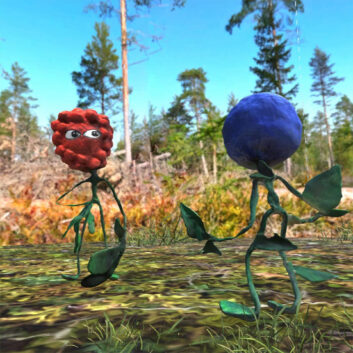
AMBULANCE (Kaisa Penttilä & Reetta Neittaanmäki):
The Grouch
The viewer meets two quarreling berries in the bottom of a clear cut forest. Blueberry is whining because they suffer from the draught and light generated by the cutting of the forest whereas Raspberry is doing just fine.
(360 photography, photogrammetry, #D and stop motion animation and motion capture. The viewing file format is APK. Roles: Blueberry – Juho Milonoff & Raspberry – Vilma Melasniemi)
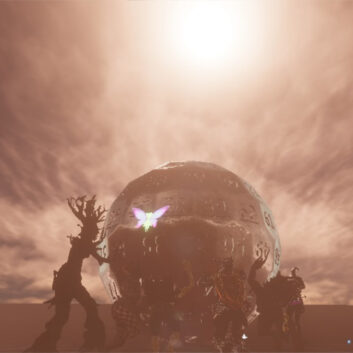
Benjamin Pompe:
Doppelgänger / Hundreds of Tosses and Tumbles
A goblin, an elf, a witch, a tree, seven archetypal characters endlessly take turns rolling a massive D100 die. Drawn from the aesthetics of fantasy and tabletop gaming, these figures inhabit a loop between chance and compulsion, ritual and glitch. The die becomes a symbol of uncertain agency: the characters throw it, yet its outcomes remain elusive, much like our own interactions with platforms, systems, and digital selves.
Pome uses performance, motion capture, and animation to explore how identity is constructed through repetition, in games and everyday life. “We all shift between roles,” he says. “Who you are with your friends is not who you are with your family, or in a performance, or online. These aren’t deceptions, they’re versions of yourself”. So then, are our avatars not doubles, but simply other selves, caught in different loops?
Benjamin Pompe moves fluently between the digital and physical, often blending the aesthetics of internet culture with historical references, myths, and fantasy. Based in the Netherlands, his work takes form through printing, video installations, performances, by reassembling them into worlds that feel simultaneously alien and oddly familiar.
The work: Hundreds of Tosses and Tumbles (2025),
Name 2 minute 3D animation loop
Technical Information: Made using downloaded animation loops, motion capture suit data and 3D hand animation. The characters are made using the Zbrush sculpting tool, Blender sculpting tool, 3D scanning (Heges 3D LIDAR scanner) and AI Luma Genie 3D generator. Made and realised with the use of various 3D software including Blender, Cinema 4D and Unity.
Character animation made in collaboration with William Knies
Instagram: @benjaminpompe
Benjamin Pompe is part of the group exhibition Doppelgänger, curated by Yev Kravt.
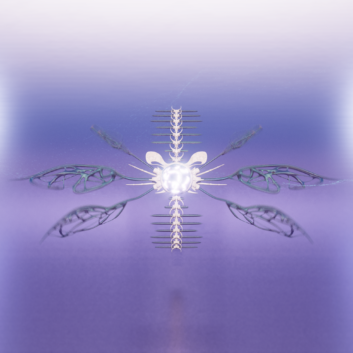
Carmilla Sumantry:
Echoes of Dystopia
Echoes of Dystopia reflects the decaying soul of the internet—a seductive mirror of our descent into dopamine-fueled escapism. Appearing as an angelic, biomechanical being, the sculpture moves in a hypnotic dance, blurring the line between organic life and artificial simulation. This piece is a rendered video from a real-time audio-reactive visualizer.
(Modelled with Blender, Animated in Unreal Engine as a real-time audio-reactive visualizer.)
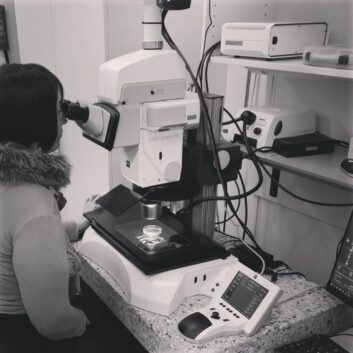
Christelle Mas:
Space Aqua Utopia
”Space Aqua Utopia” 2025 is a new video series exploring futuristic, utopian landscapes where nature and technology merge. Created using 3D microscopic imagery of insects, tardigrades, and snakes captured at the Oulu Biocenter, the project imagines hybrid environments that echo the speculative world Using the scientific software Imaris—a powerful tool for 3D and 4D visualization and analysis of microscopic data—I transformed biological structures into surreal digital terrains. These otherworldly ecosystems invite viewers to reflect on biodiversity, interspecies coexistence, and the aesthetic potential of scientific data.
(Videos with sound)
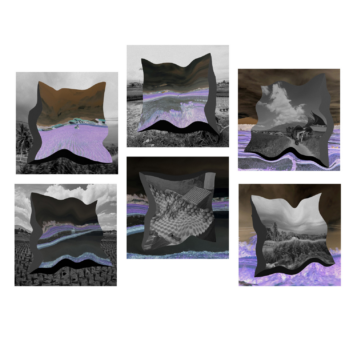
Eko Saputra:
Batang Buo
Batang Buo is a narrative about the homeland and the connection between memory and connection. In the era of technology, memory became faded and somehow artificial.
This series utilizes hyper-reality filters and 3D sculpting of the photographs, providing a graphic testament to the prominent role technology plays in our lives, to the point where it morphs our perception of the world around us. The juxtaposition of the unaltered landscape with layers of artificiality underscores our increasing dependence on digital technology.
(Digital collage and image manipulation, Audio poetry with original narration)
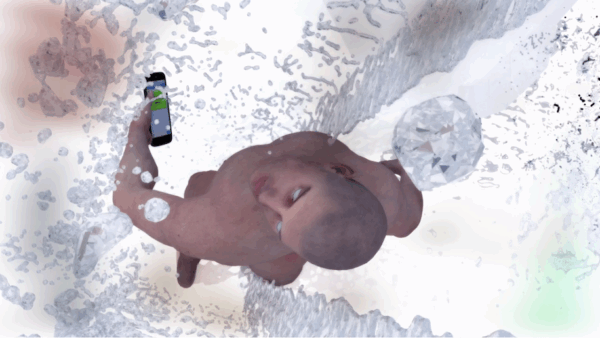
Eva Papamargariti:
DÖPPELGÄNGER
A hand hovers. A screen responds. In Soft Touch, Eva Papamargariti explores the intimate language of the interface, the choreography of fingers against glass, of emotion rendered tactile through touch. When we are communicating through our avatars, dispatched through digital profiles, how does this intimacy travel? And how is it received?
Set within the folds of a digital dreamscape, Soft Touch considers how a caress might be coded, compressed, and still arrive intact. Fragments of philosophy and pop lyrics, Plato, Derrida, Frank Ocean, float around the body’s desire to reach, to feel, to be felt. Touch becomes both performative and displaced: sometimes directed at a lover, sometimes looping back to the device itself. The screen is no longer a window. It is a skin.
Papamargariti’s work moves fluidly between synthetic landscapes and sculptural emotion, where avatars breathe and pixels pulse with affect. Her practice delves into the merging and dissolving of our surroundings with the virtual, the mundane and the miraculous folding into each other, where acts of longing, identity, and desire morph without ever losing their grip. A sticky note appears: Why do I look different on my phone than in my house mirror?
Eva Papamargariti is a visual artist, working across 3D animation, installation, sculpture, and sound. Her practice navigates simultaneity and soft collisions, between digital and physical, intimate and artificial.
The Work: Soft Touch (2023)
Website: evapapamargariti.com
Instagram: @evapapamargariti
Technical info: Single-channel video, 6’33”, sound
Eva Papamargariti is part of the group exhibition Doppelgänger, curated by Yev Kravt.
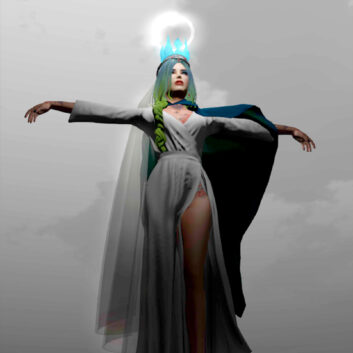
Fabiana de Barros:
Doppelgänger /
Santa Milla
Santa Millagrosa, avatar turned saint. Conceived within the pixelated dreams of Second Life, Millagrosa was born as a digital counterfigure, a character who could do everything and anything. She helped others with the ease of a click, a swipe, a beep of the credit card. A facilitator in a fragmented digital world.
Millagrosa emerged from Fiteiro Cultural, Fabiana de Barros’s long-running mobile project: a culture kiosk without a fixed address, setting up in streets, plazas, festivals, and institutions from Brazil to Switzerland and eventually, the virtual. Between 2007 and 2012, the kiosk became a hub of informal exchange, hosting conversations, cinema, and performances in Second Life. Santa Milla is one of its spectral offspring: a patroness of porous borders and networked displacement.
Once the kiosk fell silent in Second Life, Santa Milla evolved into a saint. “In the church, saints are often ‘ordinary’ people who have done extraordinary good,” de Barros notes. “So too, in the digital: we can sanctify our avatars, for memory, for care, for the traces of good they leave behind. Perhaps what we need now is a bit of spiritual help, a guide for the ghostly terrain we inhabit daily.”
For Doppelgänger, Santa Millagrosa reappears, a fictional saint for the digitally disoriented. She greets visitors at the exhibition’s entrance with a soft invocation:
“O glorious Saint Millagrosa, by the light of your holy candle, illuminate my virtual path, my memories, and my files.”
This prayer becomes a ritual for navigating corrupted folders and broken hyperlinks. She doesn’t promise miracles, only a form of grace within the system.
“Guide me to the sanctity of open source and data protection, to the safe haven of eternal happiness in the grace of digital sobriety.”
Fabiana de Barros is a Swiss artist born in Brazil, working between Geneva, Switzerland and Sao Paulo, Brazil. De Barros creates interventions and interactive performances to establish an individual relationship with the viewer in the public space.
The work: Santa Millagrosa
Technical Details: Mixed-media digital sculpture, video, and prayer card
Instagram: @fabianadebarros
Fabiana de Barros is part of the group exhibition Doppelgänger, curated by Yev Kravt.

Faysal Mroueh:
Doppelgänger /
Salamandrine Relics
In virtual space, scale often seduces. But for Faysal Mroueh, the portal lies in the detail. Twin Salamanders presents five pieces of digital jewellery, earrings, a choker, a collier, and a sci-fi butt plug, arranged as archaeological objects inside a virtual display case. Designed for a speculative RPG-inspired world, these fragments blend medieval gaming tropes with queer ornamentation and mythological inference.
At the center slithers a recurring form: the twin salamanders, drawn from gaming lore and myth, creatures said to be immune to fire, the relics granting the wearer the ability of fire resistance within the game’s logic.
These hybrid objects act as relics and mechanics, charm and commentary, evoking both protection and desire. Rather than constructing a vast open world, Mroueh zooms in, inviting us to linger in microcosmic terrain, where identity, power, and digital intimacy are encoded in precise, sensual forms.
Faysal Mroueh is a digital artist based in Amsterdam, working with game engines, experimental world-building, and the affective textures of virtual design.
The work: Twin Salamanders (2025)
Technical details: 3D game asset
Instagram: @wheretherehasbeen
Faysal Mroueh is part of the group exhibition Doppelgänger, curated by Yev Kravt.
Instagram: @wheretherehasbeen
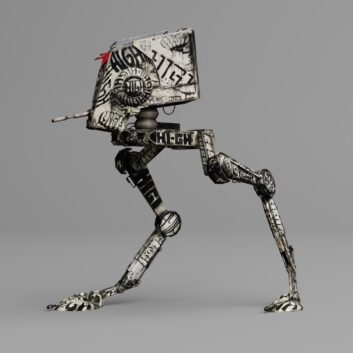
flyAR & Sheikki:
flyAR meets Sheikki in a galaxy HI-GH.
HI-GH away
How HI-GH is the galaxy anyway?
Can things exist physically and digitally in multiple positions of the reality spectrum at once? The answer to both is yes.
https://flyar.fi/high-af for a web and mobile AR-version.
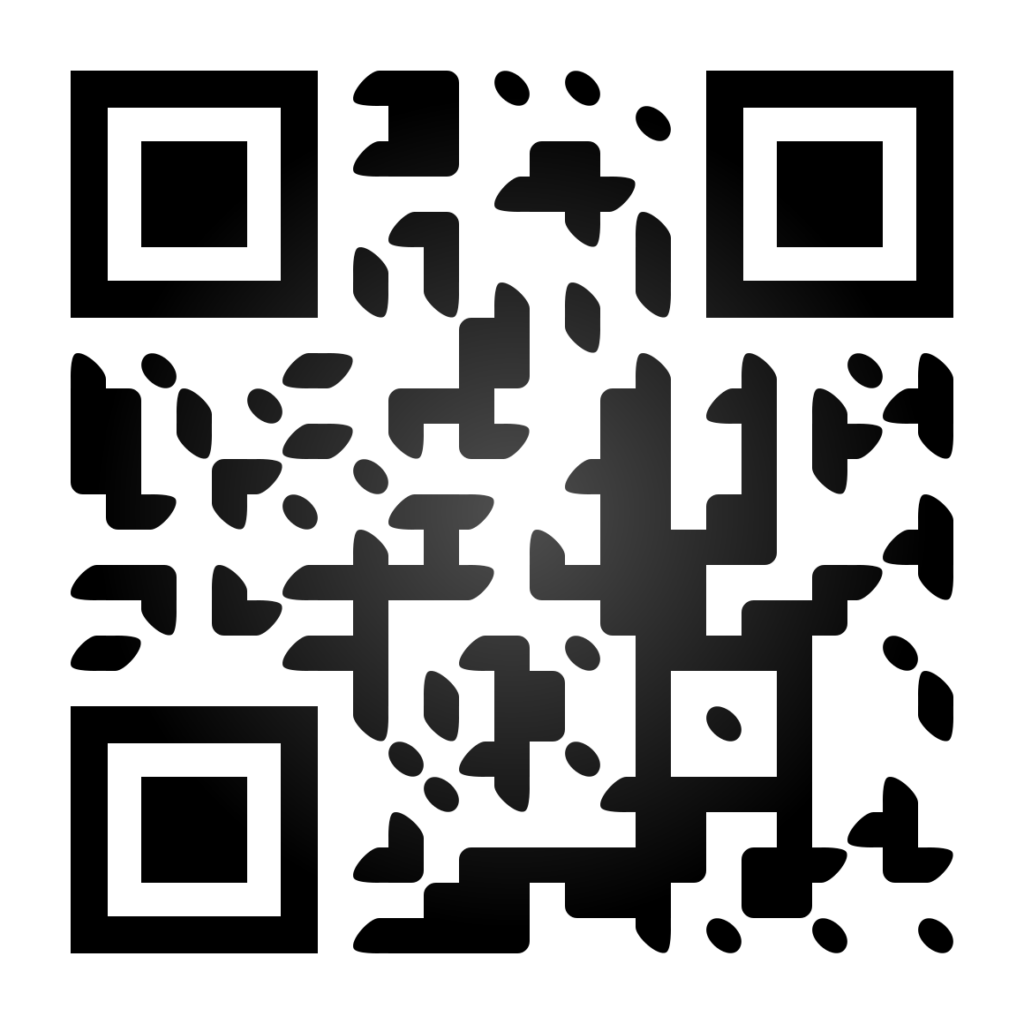
(Physical sculpture by multidisciplinary artist Sheikki, brought into digital life by flyAR Augmented Reality Studio. Manually modeled, textured, rigged and animated based on reference imagery and photogrammetry. Format: fbx.)

Gohar Martirosyan:
Doppelgänger / Identity
Gohar Martirosyan
DÖPPELGANGER
A figure splits, doubles, replicates. Gohar Martirosyan presents Identity, a VR film that explores personal identity not as a fixed state, but as a fluid multiplicity. In this immersive work, selfhood does not emerge as a unified construct but as a fractured fresco, shaped by migration, diasporic memory, gender expression, and cultural displacement. The body may remain still, but the psyche is in motion: layered, colliding, resisting coherence.
The narrative unfolds through the intimate voice of Sacha Eusebe, a South African artist based in France, whose lived experience traverses intersecting cultural, racial, and gendered realities. With a background that includes collaborating with Anne Imhof, modeling for Balenciaga, and working behind a desk at a Marseille rave club, Sacha becomes the film’s gravitational center, a prism through which Martirosyan sketches a counter-cartography of identity: disidentification, embodied plurality, and in-betweenness.
The work draws inspiration from The Diary of Anaïs Nin, Vol. 1, whose words surface like a refrain:
“I have always been tormented by the image of a multiplicity of selves. Some days I call it richness, and other days I see it as a disease […] My first concept about people around me was that all of them were coordinated into a whole, whereas I was composed of a multitude of selves, of fragments.”
The VR film Identity doesn’t necessarily ask who you are. It asks how many of you are there and what it means to live with them all.
Gohar Martirosyan is Paris based Armenian film director and digital artist with background in fine arts, performance & site-specific installation.
The work: Identity (2022)
Technical details: VR Film
Voice Acting Sacha Eusebe
Motion Capture Performer Jennifer Gold
Sound Design & 360° Sound Mix Nicolas TEP
Produced by Le Fresnoy
Instagram: @goharmartirosyan
Gohar Martirosyan is part of the group exhibition Doppelgänger, curated by Yev Kravt.
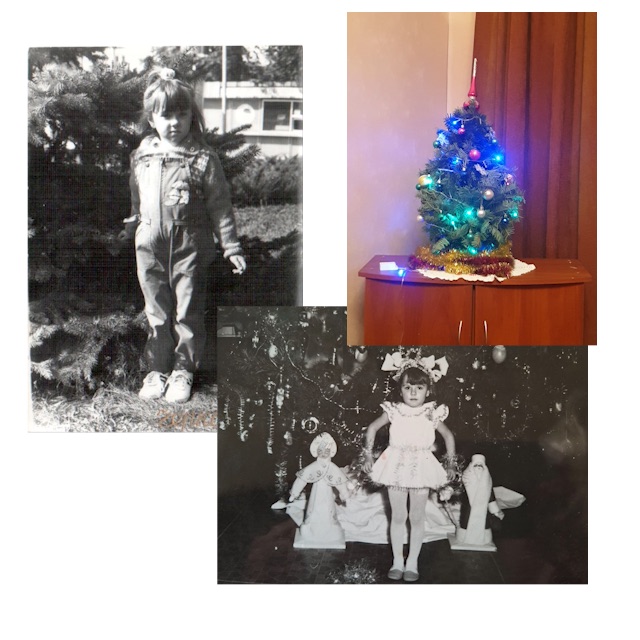
Hanna Trofimova:
Calls to Oneself
Calls to Oneself is a video art project composed of reflective dialogues addressed to the self at
different life stages: childhood, pivotal life moments, and key transitions shaping identity. It explores
memory, resilience, and how individuals respond to personal and societal changes.
Combining archival footage, personal video and photo materials, and contemporary video, the work
offers a layered narrative of memory, loss, and inner transformation.
(Video art installation presented on three synchronized screens, with sound and voiceover. Duration: 5:20Year: 2025)
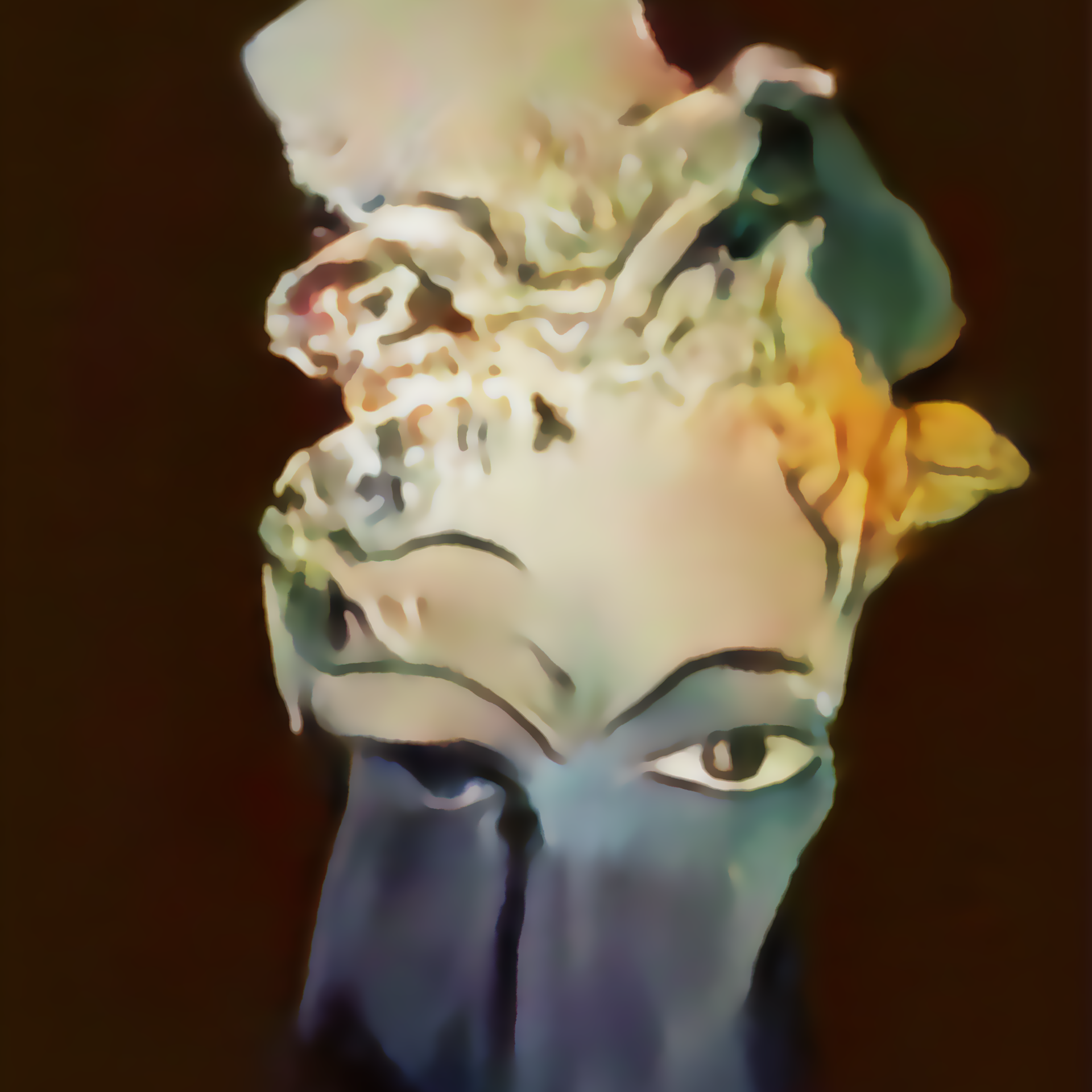
Harshit Agrawal:
Digital (Dis)embodiments / Machinic Situatedness & Masked Reality
Machinic Situatedness is a series of artworks that uses artificial intelligence (AI) to explore the subject of ’cultural situatedness’ and influences in the genre of AI art.
These works are created by an AI that draws inspiration from Buddhist painting styles to create an abstract, dream-like output using GANs. This series asks the questions: what is an AI machine’s cultural underpinning, and how can we broaden its scope?
These draw a lot of reference from Nam June Paik’s TV Buddha work, here alludes to the cycles of transcendence that we undergo as a species, continuous cycles of trying to become something more than ourselves, which we are now channelling through the evolving role of AI in our lives and AI itself is by learning more from us.
Masked Reality is a series of artworks that uses artificial intelligence (AI) to explore the subject of faces, traditions and identity, especially its malleability in the age of technology.
These works are created by an AI drawing inspiration from the mask cultures of the central region of India. This juxtaposition of the traditional with the modern, both used to engage with the world from new vantage points, is an attempt to think of alternate visual cultures of AI, too.
https://www.harshitagrawal.com/
This work is part of the group exhibition Digital (Dis)Embodiments curated by Shashank Satish
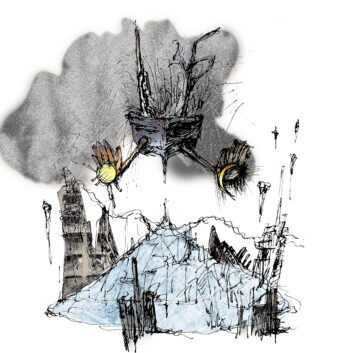
Hui Zhang & Zoey Zhao:
SeeKing
Tri-eyed, Sun and Moon in palms, watching the three realms.
(Custom Unity based production)
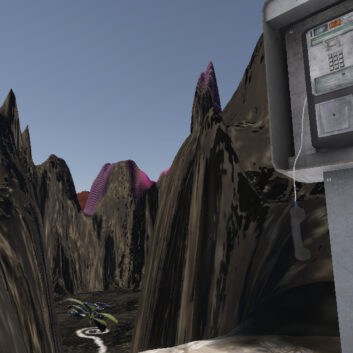
HYENAZ:
ENTANGLEMENTS
”HYENAZ: ENTANGLEMENT” is a VR experience that invites participants to explore their own entanglements with objects, landscapes, and extractive processes, with HYENAZ as their guide. In a fantastical environment—immersed in soundscapes and textures recorded through HYENAZ’s slow-movement research project in sites of environmental extraction—objects reveal their animacy, and participants are invited to engage in speculative storytelling to deepen their understanding of interrelationality.
(Multichannel spatial audio, series of videos, interactive elements)

Jamie McGhee:
The Last Broadcast
What is the truth beyond the spectacle? “The Last Broadcast” is an interactive, text-based narrative that explores propaganda, myth-making, and the role of the metaverse in both.
THE LAST BROADCAST (web-version)
(Branching narrative built on Inklewriter software.)
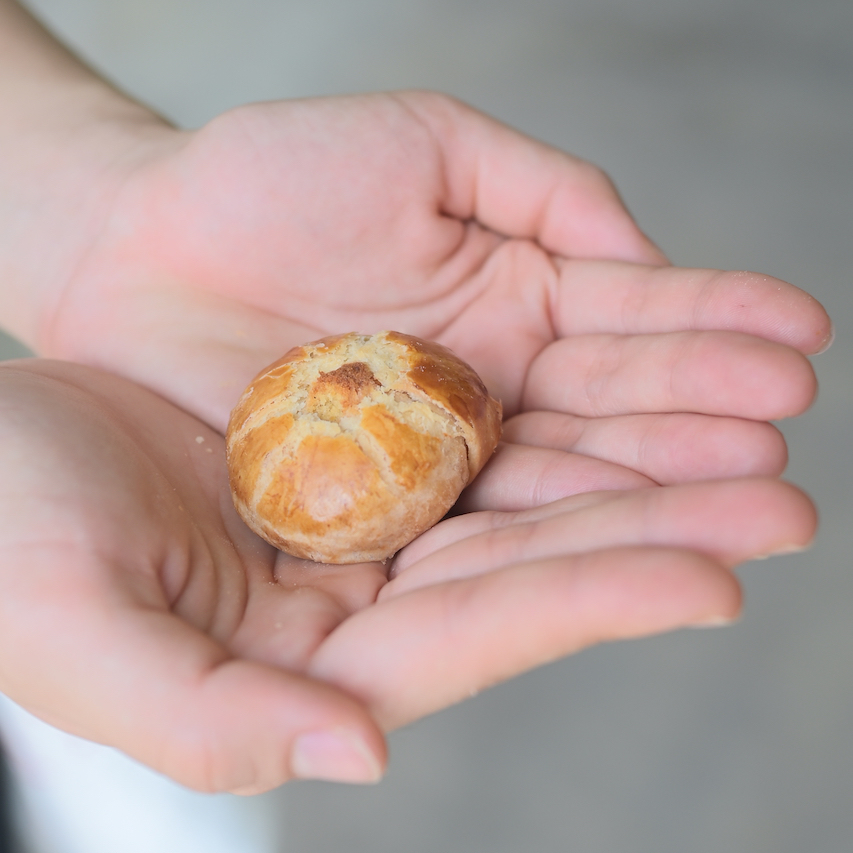
JinnD Productions /
Tau Sar Piah Biscuit Baker x Contemporary Dance:
Beyond Moving with Artisans
Beyond Moving with Artisans (BMoA) is an interdisciplinary dance project that brings new life to endangered Malaysian cultural trades by merging traditional knowledge with contemporary performance and technology. This edition highlights the story of the late tau sar piah baker, Mr. Sim Ah Ba, transforming his oral history into an interactive storytelling experience. Through movement, digital media, and community engagement, BMoA celebrates cultural heritage while fostering intergenerational connection and renewed appreciation for artisanal wisdom.
(Co-Producer/ Choreographer: Lau Beh Chin (Jinn)
Dramaturg/ Multimedia Art Director: Ridhwan Saidi
Creative Technologist Team: FABU
Performers/ Collaborators: Low Xin Ping, Winnie Xuan, Wong Chi Ying
Co-Producer: Low Pey Sien
Artisan: Mr Sim Ah Ba & Family)
Lau Beh Chin: https://www.instagram.com/jinnd_productions/
Ridhwan Saidi: https://mokamochaink.com/
FABU: https://fabu.com.my/
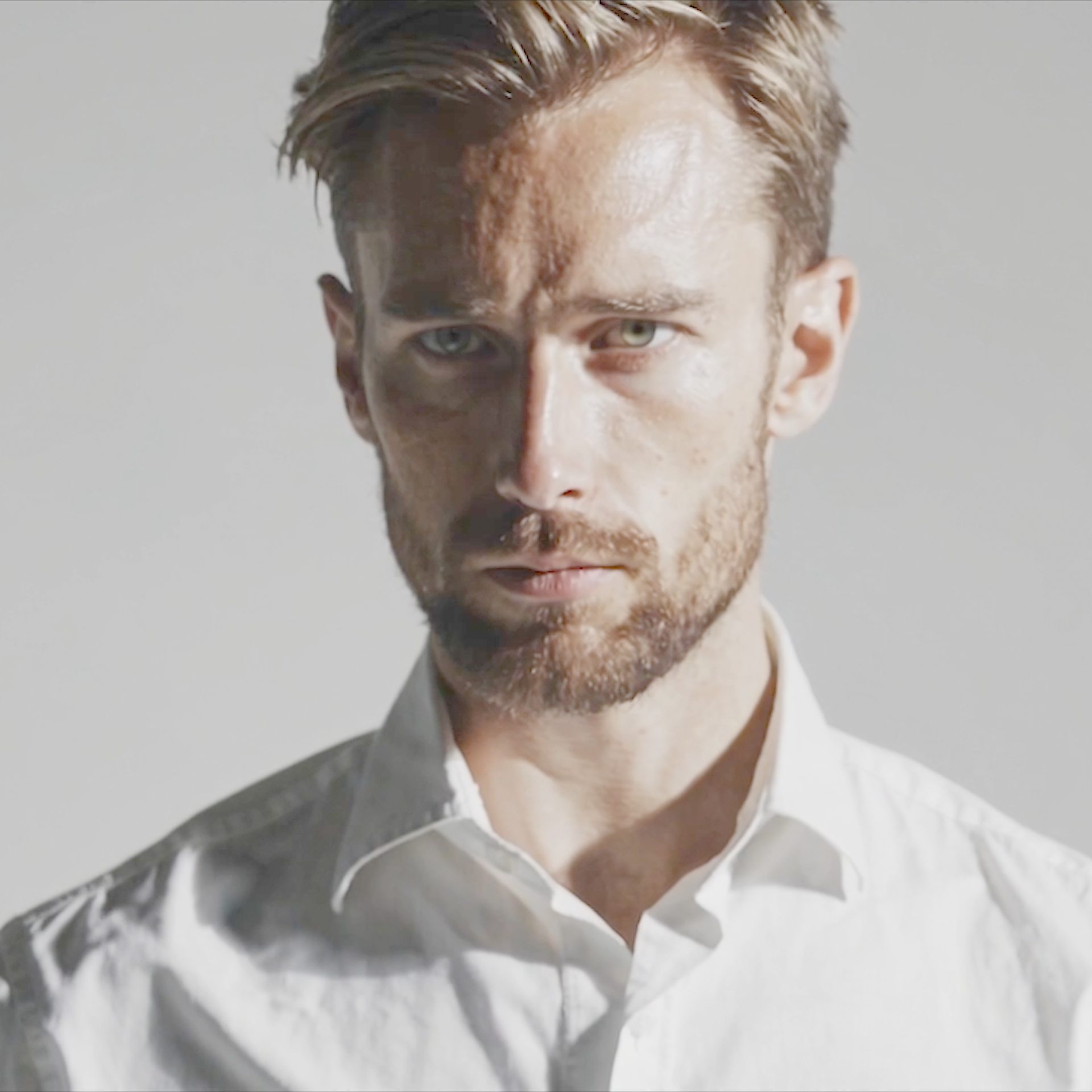
Jonas Lund:
Doppelgänger / How To be Human
Jonas Lund
DÖPPELGANGER
A tutorial, a ritual, a glitch. In How to Be Human, Jonas Lund stages a series of algorithmic exercises, simulating nine everyday actions, drinking coffee, checking a mirror, dancing, through the lens of machine logic. Each gesture is performed three times, recited with mechanical detachment, as if pulled from a behavioral script written by artificial intelligence. The setting is sterile, institutional: a white virtual office resembling a research lab or alien observatory. Humanity, here, is the subject of study.
Lund calls it a “performance test for AI’s understanding of physicality.” But beneath the clean repetitions, something unravels. The more the gestures repeat, the more they mutate. A strange tension emerges between idealized behavior and the emotional messiness of embodiment. What begins as analysis becomes mimicry, then distortion. The human becomes data. The data mimics humanness.
At its core, How to Be Human is a doppelgänger film, a study of doubling. Each action spawns versions of itself, rehearsed, revised, subtly misaligned. “The AI attempting human gestures creates its own doppelgänger of humanity,” Lund notes. “Imperfect, but revealing.”
In a world shaped by algorithms and predictive behavior, Lund invites us to ask: is selfhood becoming more performative, or are we simply witnessing the performance that was always there? The result is both unsettling and precise, a mirror not of who we are, but how we’re watched, measured, and made legible.
Jonas Lund creates paintings, sculpture, photography, websites and performances that critically reflect on contemporary networked systems and power structures.
The work: How to Be Human, 2024
Technical details: Video, 7:29 min
Instagram: @jonaslund
Jonas Lund is part of the group exhibition Doppelgänger, curated by Yev Kravt.
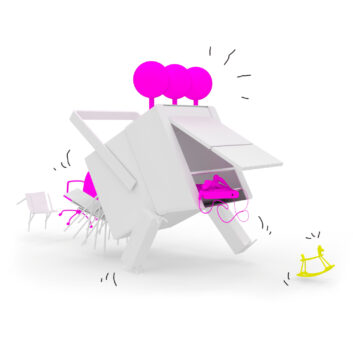
Jukka Hakanen:
Recycled 3D Monsters
I studied design between 2007 and 2015 at various institutions and created dozens of different concepts, products, and artworks. From these school projects, I have several 3D files left, filling up my hard drives.
By combining my old 3D files, I have created various characters called “Recycled 3D Monsters” that wander through the spaces of the Virtual Art House. Each character has been created based on the available materials, reflecting the moods of the moments they were made.
(3D illustrations)
Kathryn Carter:
Semiotics of Spacelessness
Semiotics of spacelessness by Kathryn Carter orients us in our imaginations as we chart the synthesised terrain of the Virtual Art House. Her words, by virtue of their mortality, invite observers to expand the incubation of their own ideas and to return to the corporeality of their physical vessels as they traverse the digital realm. With poetry, we may transform the phantom of the virtual with palpable expression.
Intrigued by the nascent semiology of intangible worlds, Carter presents thirty-three poems created as the chrysalises from which the reader’s own wings may emerge. What becomes of embodied humans who are disembodied within the simulacra of coded landscapes? There does not have to be one answer, but in alignment with your intuition your metamorphosis will be mapped by your own poetry.
(Words)
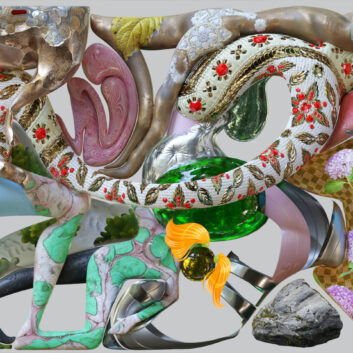
Kévin Bray:
Doppelgänger
For Doppelgänger, Kévin Bray brings his hybrid, media-fluid practice into the virtual realm, blurring the borders between cinema, illustration, sculpture, sound, and code. His work explores how language, images, and narratives are constructed, deconstructed, and reassembled across platforms and epochs. Moving between past and present techniques, Bray retools communication strategies to reveal the fiction embedded in reality and the realities embedded in our fictions.
His approach challenges the authority of tools, pushing them toward moments of crisis. By actively shifting his attitude throughout each phase of production, Bray treats making as a political gesture a resistance to dogmatic cycles that shape not only what we create, but how we perceive. “The tool,” in his work, “is never neutral.”
Bray emphasizes the act of collage rather than montage, revealing the layered anatomy of image construction. At the edge of transparency and concealment, his work stages a tension between illusion and exposure a system always in motion. Anima, animated, animal, animism, the work resists stillness, always shape-shifting, always in translation.
Instagram: @bray_kevin
Technical Information: (to be added)
Kévin Bray is part of the group exhibition Doppelgänger, curated by Yev Kravt.
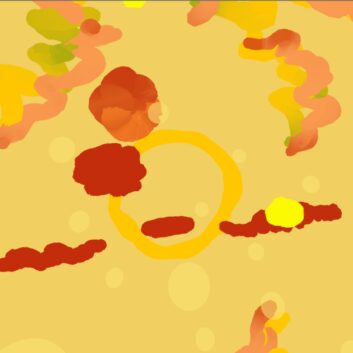
Leena Jääskeläinen:
Crinkly Crumpets – ASMR VR
Move around, look and listen. Do you feel tingles? CRINKLY CRUMPETS is a series designed for relaxation in VR. It combines colorful abstract animation and pleasant ASMR sound.
Total immersion in colorful goodness with soothing soundscape!
(Custom Unity builds with spatial sound. Sound design: Janne Laine)
Artist webpage
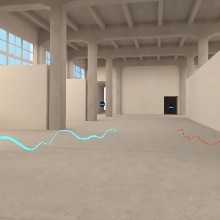
Maciej Tomaszewski & Eero Tiainen (Springplay Studio) :
Animator
ANIMATOR – LIVE PERFORMANCE
Animator showcases how much life and personality is radiating even from the simplest signal of existence – a moving dot that leaves a trace. What happens when a dot meets another?
(performance)
ANIMATOR – THE TOOL
Life is motion. You will never stop moving as long as you breathe. Animator – The Tool calls you to explore the simplest signal of existence and become the animator yourself!
(interactive play)
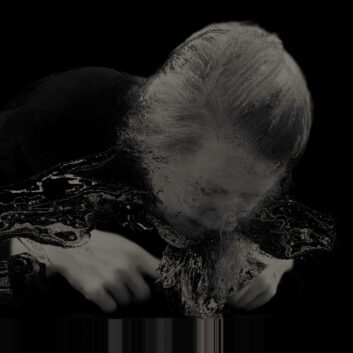
Maria Nurmela & Vesa Loikas:
Digital (Dis)Embodiments/ 9000 IN METAVERSE
9000 IN METAVERSE is a multidisciplinary art exhibition by photographer-filmmaker-architect Vesa Loikas & Choreographer-dancer Maria Nurmela.
9000 IN METAVERSE explores the changing meanings of humanism within a posthumanist framework.
(Three-dimensional sculptures, video with soundtrack, fine art photography and text)
This work is part of the group exhibition Digital (Dis)Embodiments curated by Shashank Satish
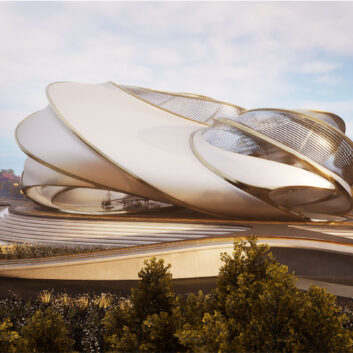
Maria Touloupou:
Doppelgänger /
PORTAL²
A portal is never just a door. In PORTAL², Maria Touloupou created a spatial threshold that initiates transformation and reflection. Conceived as a twin-looped passage, the structure recalls the yin-yang, opposite forces that turn in orbit but never fully align. Visitors must pass through this recursive form to enter the exhibition Doppelgänger.
Touloupou plays with the tension between versions of ourselves that aren’t quite the same as in real life. “It’s about stepping into your digital double,” she says, “the version of you that lives online, or in code.”
Trained as an architect and fluent in digital myth-making, Touloupou moves between structural design and emotional cartography. Her work explores how form can be both symbolic and sentient, a space that senses as much as it shelters.
PORTAL² floats in a world without weight. “I wanted to create something anchoring,” Touloupou notes, “even in a space without physical limits.” Rather than overwhelm, the work invites intention: an inner double-click before entry. With so many tools these days, AI included, it’s easy to generate spectacle, dopamine clickbait: shiny, impressive forms that move fast but don’t always mean much.
Instead, PORTAL² slows the moment down. Its use of sacred geometry gestures toward something ancestral, a visual language that predates the digital but now reemerges through it. A place not of arrival, but of becoming.
The work: PORTAL², 2025
Technical information: Medium: 3D architectural model, digital twin environment; Designed in: Autodesk Maya; Rendering Workflow: Unreal Engine 5 / optimized for Unity/WebGL.
Instagram: @maria_toul.
Maria Touloupou is part of the group exhibition Doppelgänger, curated by Yev Kravt.
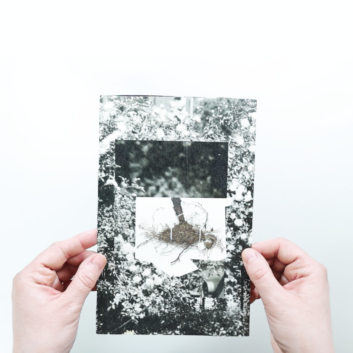
Marie Samuel Levasseur:
The Flipping room / Micro stories Unfold
The Flipping Room: Micro-Stories Unfold
In this immersive virtual exhibition, Canadian artist Marie Samuel Levasseur presents over a hundred zines and small artbooks – many of their own, a hundred created through collective workshops, a zine from the Fanzinothèque collection (France) and a selection by fellow artists from Canada, the U.S., Spain, and Germany.
Each zine is revealed through a quiet, intimate gesture: the turning of its pages, one by one, for someone else to see. Inspired by the artist’s experience as a caregiver, this simple act becomes a form of care – a way to share stories gently, attentively.
Through these small books and the many hands that helped create them, The Flipping Room offers a space of connection, reflection, and quiet resistance, where micro-narratives unfold across borders and screens.
(A virtual video installation composed of multiple screens, each triggering a video of zines being flipped page by page.)

Mica Cabildo & Curtis Cresswell :
Guardians of Cloud and Moss
Nature reclaims the digital world. Using their catalogue of textures and forms collected from fieldwork in temperate Celtic rainforests of Wales and tropical montane cloud forests of the Philippines, Curtis and Mica bring pockets of mossy forests and fern-laden woodlands to the VAH Building.
(3D objects of forest elements to be spread out in spaces within the Virtual Art House building)

Michalis Charalambous:
Doppelgänger /
We Meta Love Death
A decaying wall rises in a dreamscape. Flowers bloom unnaturally. Statues fragment, hover, and mutate. In We Met – Love Death And Meta, Michalis Charalambous constructs a virtual environment where memory, grief, and digital resurrection converge. It is an emotional terrain shaped by absence, and the longing to make absence feel again.
The work drifts between archaeological reverie and speculative afterlife. Hybrid beings gather: horned deities, damaged objects, vegetal ghosts. The graffiti scrawled across the central ruin speaks to lost connections and half-forgotten languages. “My doubles,” Charalambous notes, “are not mirrors, they are echoes. Ghosts in the algorithm. Versions of the self that persist in code, even after we log off.”
Trained in sculpture but operating in extended reality, Charalambous uses VR and AI not to mourn. His materials are spectral: scanned relics, 3D flowers, digital clay. Each carries emotional residue. We Met – Love Death And Meta speculates on what happens after touch, after presence, after death itself, when memory becomes architecture, and intimacy is reconstructed through simulation.
At its core, this work asks a quiet, radical question: Can avatars remember for us? Can they grieve?
Michalis Charalambous is a visual artist working across ceramic and digital media. His practice explores memory, identity, and the metaphysics of space.
The work: We Met – Love Death And Meta (2024–Ongoing)
Technical information: Digital sculptures, Scanned Objects and landscape, VR installation, 2024
Digital Scanned Graffiti – Artist SOAS
3D scans antiquities objects courtesy of the Department of Antiquities, Republic of Cyprus.
Instagram: @michalis_charalambous_
Michalis Charalambous is part of the group exhibition Doppelgänger, curated by Yev Kravt.

Mike Pelletier:
Doppelgänger
Bodies overflow. Faces smear. Breasts multiply. In Mutant Madonnas, Mike Pelletier invites us into a loop of reverence and rupture, where serenity slips into chaos, and classical perfection dissolves into algorithmic excess.
Using open-source AI models and Renaissance-era compositions as his prompt-image source, Pelletier reanimates visual memory through a process of digital miscommunication. What begins as a “resin sculpture of a woman” becomes a glitching saint with five arms, three mouths, and no clear origin. Sacred geometry is warped by code.
Pelletier’s figures are neither avatars nor archetypes, they are collapsed simulations, struggling to hold form. Born of repetition, filtered through baroque pattern and machine vision, they carry the traces of devotion but none of its clarity. As the artist explains, “AI doesn’t understand symbolism; it understands pattern. These images are mutations, not metaphors.”
For over a decade, Pelletier has worked at the intersection of human form and technological failure. In Mutant Madonnas, he relinquishes control, allowing the machine to lead, hallucinate, even deform. The result is a series of digital relics, eerily alive, unsettlingly divine, caught in a feedback loop between worship and decay.
The doppelgänger here is a distortion, a surplus, a scream beneath the surface. If these icons could speak, they might not say anything at all. Or perhaps, as Pelletier half-jokes, they’d whisper: Kill me.
Mike Pelletier is a Canadian-born artist based in the Netherlands. His work spans animation, digital performance, sculpture, and generative systems. He explores the poetics of control, mutation, and embodiment in an increasingly machinic world.
The work: Mutant Madonnas
Technical Information: AI Generated Digital Portraits with AI Generated depth and normal maps.
Instagram: @mikepelletiernl
Mike Pelletier is part of the group exhibition Doppelgänger, curated by Yev Kravt.
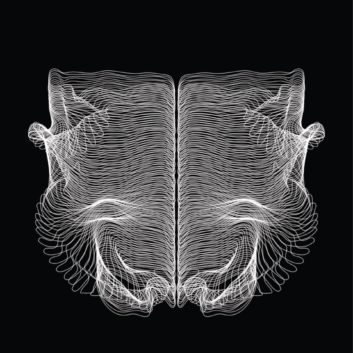
Natasha Singh:
Digital (Dis)Embodiments / Nadi
Nadi is a collective of generative new-media sculptures, translating movement in Yoga to a time-freeze entity.
Through the sculptures, I am investigating the rhythm of the body and the breath, the undulations in movement and the prana, which leads to an imagination of continuity. The form unfurls an intrinsic quality of calmness of a biological being with an embodiment of movement and breath, in the form’s convolutions.
The expansion and contraction of Nadi form preserves multilayered systems both in temporal and spatial characteristics, and the geometry of the body’s anatomy lends value to animalistic attributes. This emergence of the Body’s rhythm metamorphoses from a formless existence to an embodied self, revealing symmetry in the recursive patterns of the flow.
(Artificial Intelligence, Creative Coding, Laser cutting Programmer: Mallikarjun M)
This work is part of the group exhibition Digital (Dis)Embodiments curated by Shashank Satish
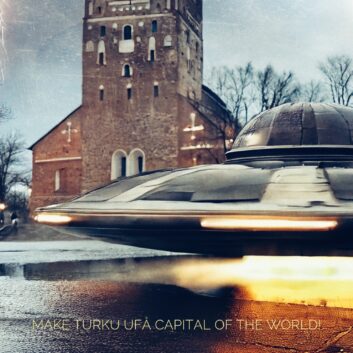
Ollipekka Kangas:
Make Turku UFÅ Capital of the World
The UFÅ VAH 2025 campaign humorously proposes making Turku the UFO capital of the world. This retro-futuristic artwork blends sci-fi aesthetics with contemporary digital illustrations, reimagining a UFO visitation as a symbolic encounter with home, locality, and imagination.
(Various digital formats, workshops, AI-integrations)
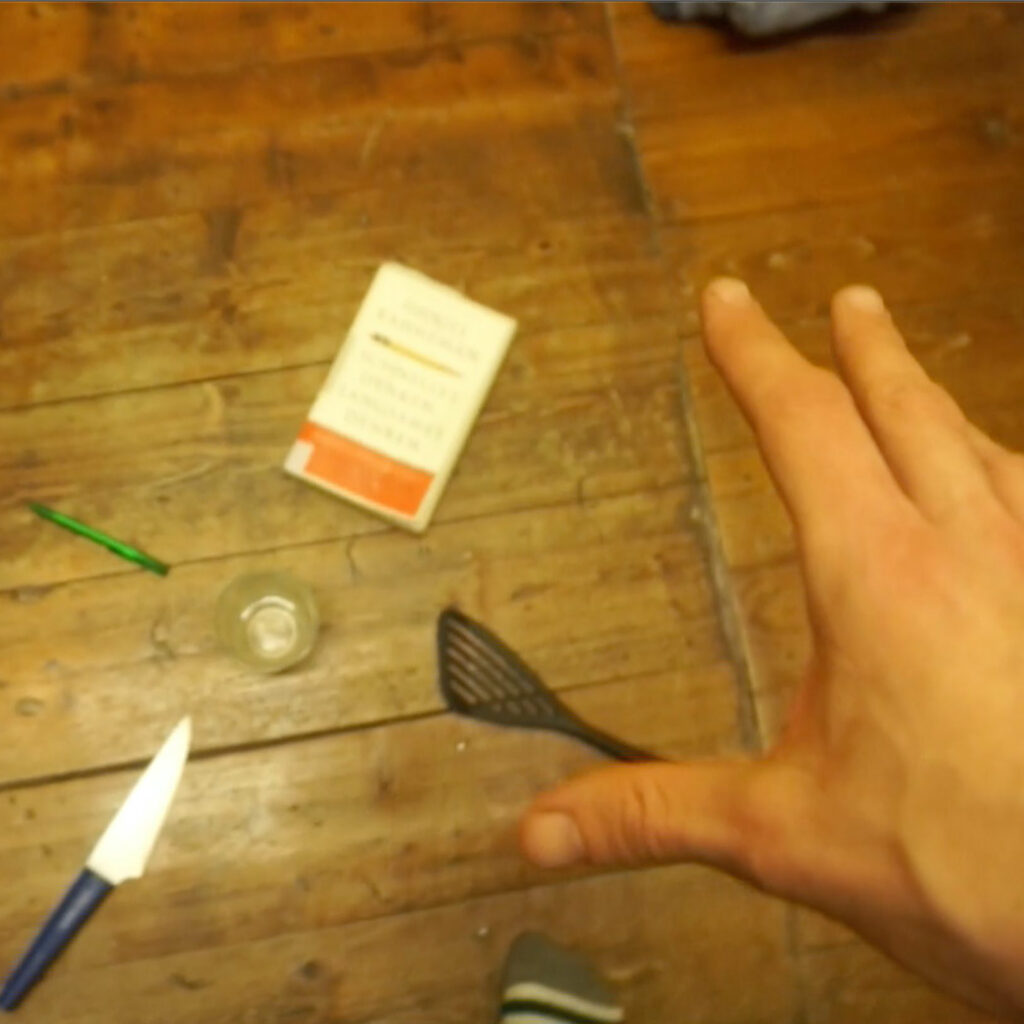
Paul Wiersbinski:
Mortal Toys & Remote Rules and Rituals
Mortal Toys: Participants were invited to join a performative game, in which they tried out prototypes of video glasses connected to wireless surveillance cameras. Strangers met in a semi-public situation and were willing to play, while they were watched by the other participants. They experimented with transmitted body movements, improvised choreographies, were “controlled” and took “control” of others.
Remote Rules and Rituals: How can the rituals of theater be used to portray the ritualism of spiritual machines. How do we use them to make predictions about an uncertain future? The audience was invited to participate actively in a collective ritual, exploring their living spaces and charging everyday objects with new meaning without leaving their home.
(HD Video PAL, 16:9, color and sound)
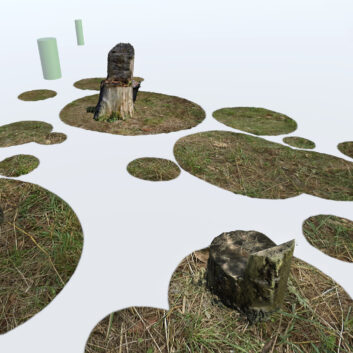
Paulo Majano:
Concert
In the project Concert, fragments of textures and sounds recreate the unique visual and auditory qualities of two locations. Direct observation and documentation are crucial parts of my process, and I use audio field recordings and 3D scanning to record and archive the everyday experience of specific places
In the VR installations, viewers can step into a concert capturing natural sounds and the sounds from human activity.
Concert-Intertidal documents a section of shoreline in Boundary Bay, an important stop for migrating birds in the Pacific Northwest, BC Canada, on the traditional and unceded territory of the Coast Salish Peoples. The installation Concert-Garden captures fragments of the natural textures and sounds in Padula, Vallo di Diano, Italy
(Sound field recordings on location, and 3D scans. The audio and 3D elements are brought together in Unity)
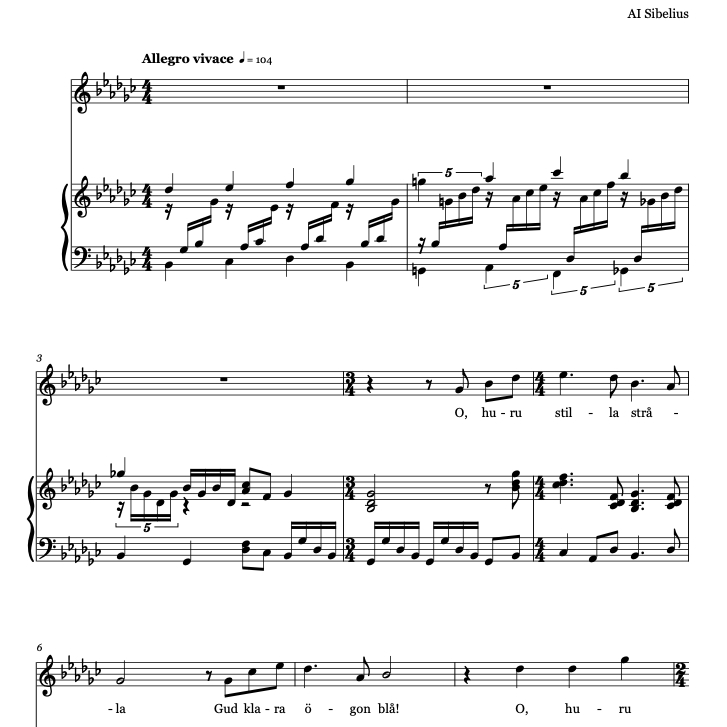
Perttu Pölönen & Lauri Mäntyvaara:
Can AI generate new music from Sibelius?
In this experimental piece, Perttu Pölönen explores whether artificial intelligence can create new music in the spirit of Finnish composer Jean Sibelius.
The work is an .mp3 audio file generated using the Suno AI tool, which produces music based on input styles and ideas. The result raises questions about the nature of creativity, cultural depth, and whether an algorithm can truly capture the essence of a master composer.
(mp3 file generated by Suno, Notes by Lauri Mäntyvaara)
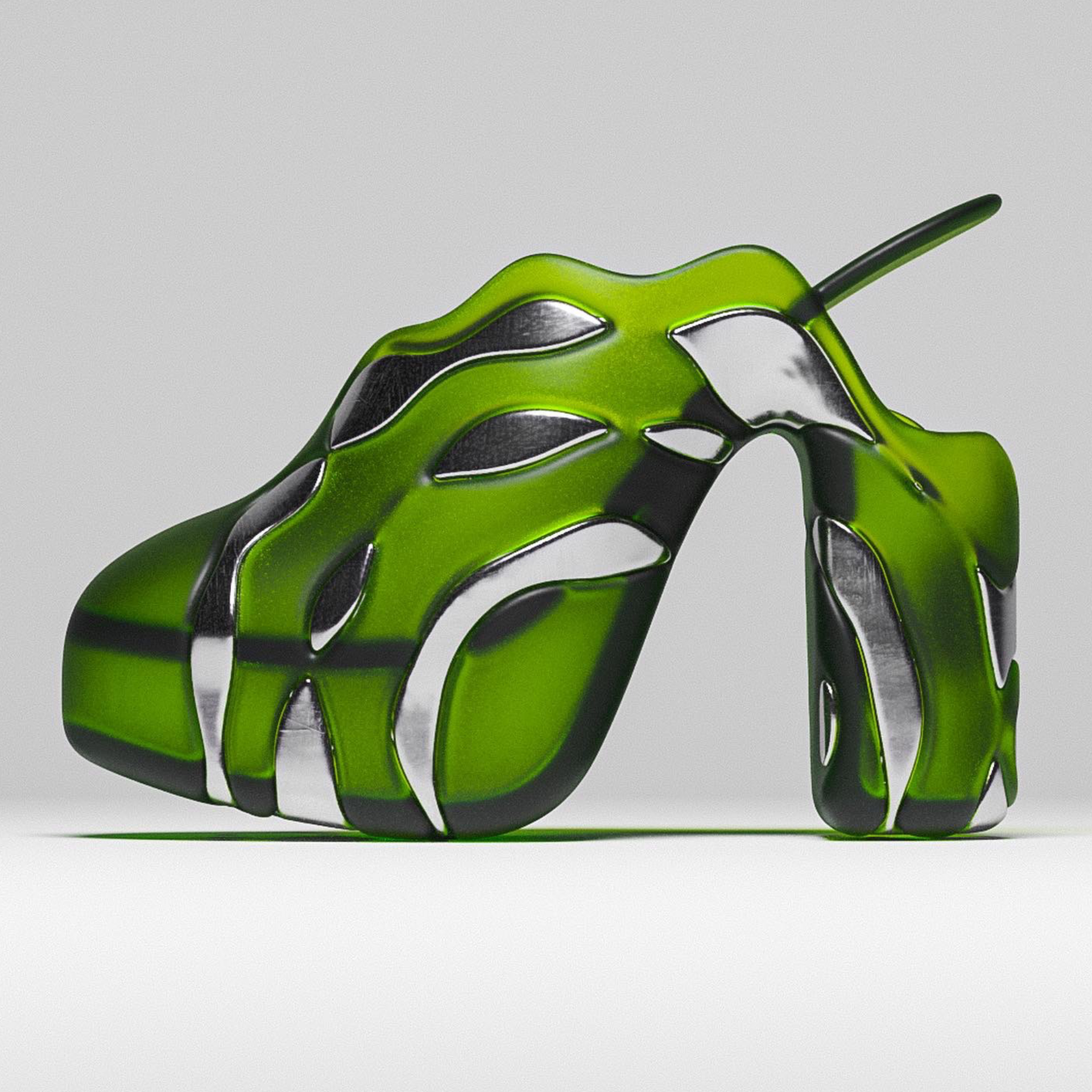
PET LIGER:
Doppelganger / Sun Disk Heels
A radiant disk floats in the virtual stratosphere, unfolding, waving, never still. Below, a pair of sculptural heels echo its orbit, looping in perpetual motion. Both works shimmer with a strange gravity, suspended in light, mirroring one another across distance like celestial twins. For Doppelgänger, digital designer and artist Constantinos Panayiotou, founder of the fashion house PET LIGER, steps beyond the body, shaping a mythology of movement, reflection, and ritual.
Known for crafting over 1,200 digital shoes, worn by avatars and collected across virtual platforms, Panayiotou here turns to the symbolic. Sun Disk Flag and Sun Disk Heels are part of a broader cosmology, one in which repetition becomes sincerity, and the copy no longer imitates but initiates. “The avatar,” he says, “is a prosthetic. It does what the body cannot. It allows us to walk in digital space, to build extensions of ourselves.”
For Panayiotou, the virtual is a continuation of reality, a place where human architecture evolves into ethereal geometry. “From the moment we built dwellings, we’ve been crafting virtual spaces,” he notes. “The avatar is just the newest inhabitant.”
The work: Sun Disk And Sun Disk Heels (2025)
Technical information: Animated sculptures.
Instagram: @petliger
PET LIGER is part of the group exhibition Doppelgänger, curated by Yev Kravt
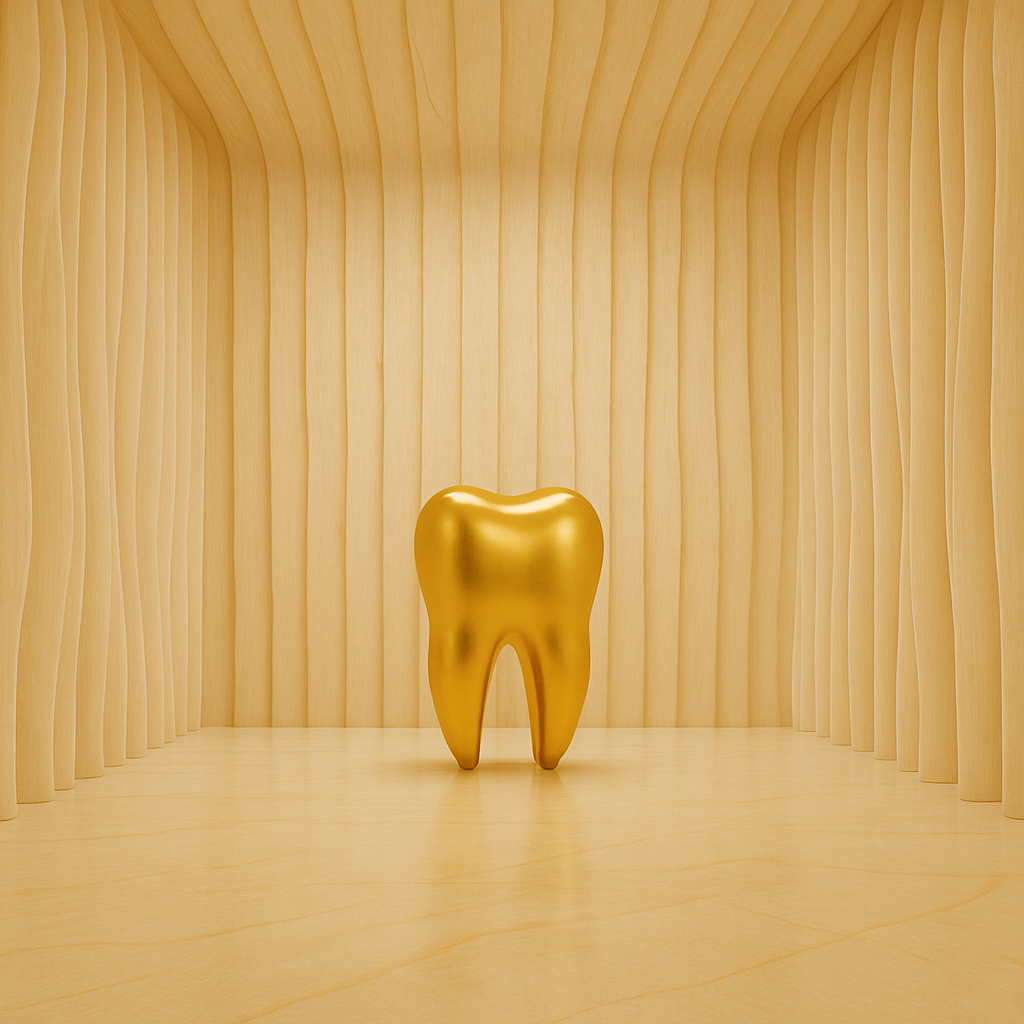
Raiël Solomon (RxSolo):
This Room…Gold Tooth
This Room…Gold Tooth is an immersive digital installation that reimagines the emotional and psychological landscape of the original This Man…Gold Tooth narrative. Audiences enter a series of surreal, responsive virtual rooms where visual elements transform in real-time, triggered by specific frequencies in the soundscape. As the sound evolves, walls ripple like fabric, lights pulse, and abstract architectural forms shift—crafting a meditative yet unsettling experience. The work explores internal conflict, memory, and psychological fragmentation, transforming sound into an active force within a living environment.
(Hybrid workflow between TouchDesigner and Blender, creating a real-time, interactive environment)
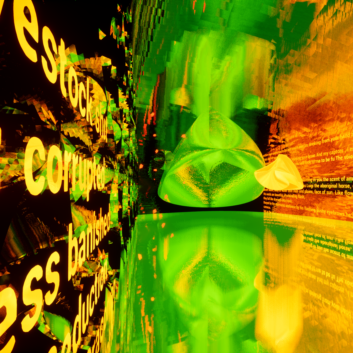
Robert B. Lisek:
HIGH-SYNTHESIS
HS is an interactive metaverse installation that visualizes and sonifies cultural, biological, and informational networks through AI, quantum algorithms, and real-time co-creation.
(Unity scripts and assets,
machine learning for data processing
agents)
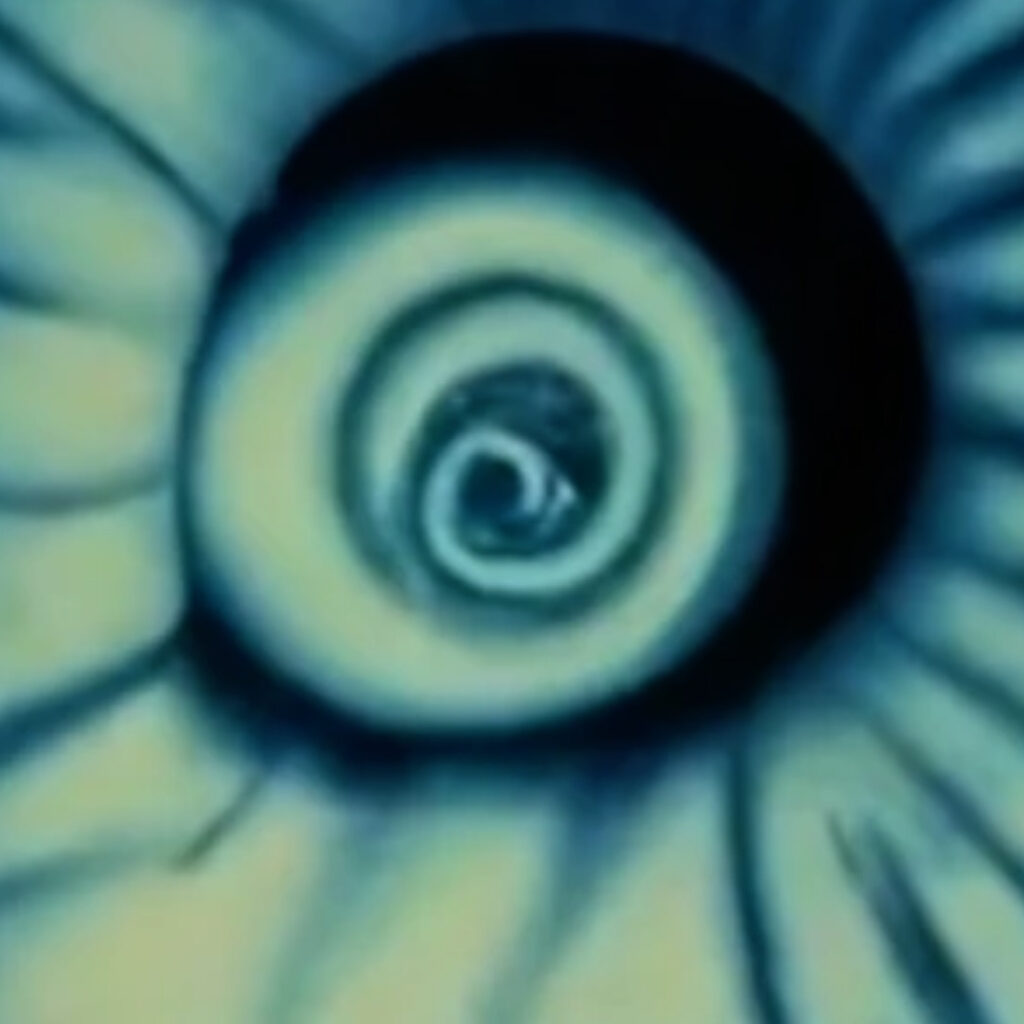
Roberto Santaguida:
How Deeply…
Reflections on life in a remote island archipelago, where isolation hangs in the air and traces of the past seem to vanish. The film pares everything down to a stark, suspended sense of time. Through fractured imagery, it navigates a quiet void, inviting viewers to inhabit the ache of absence and the gravity of what has slipped away.
(Video, 9:10 minutes)
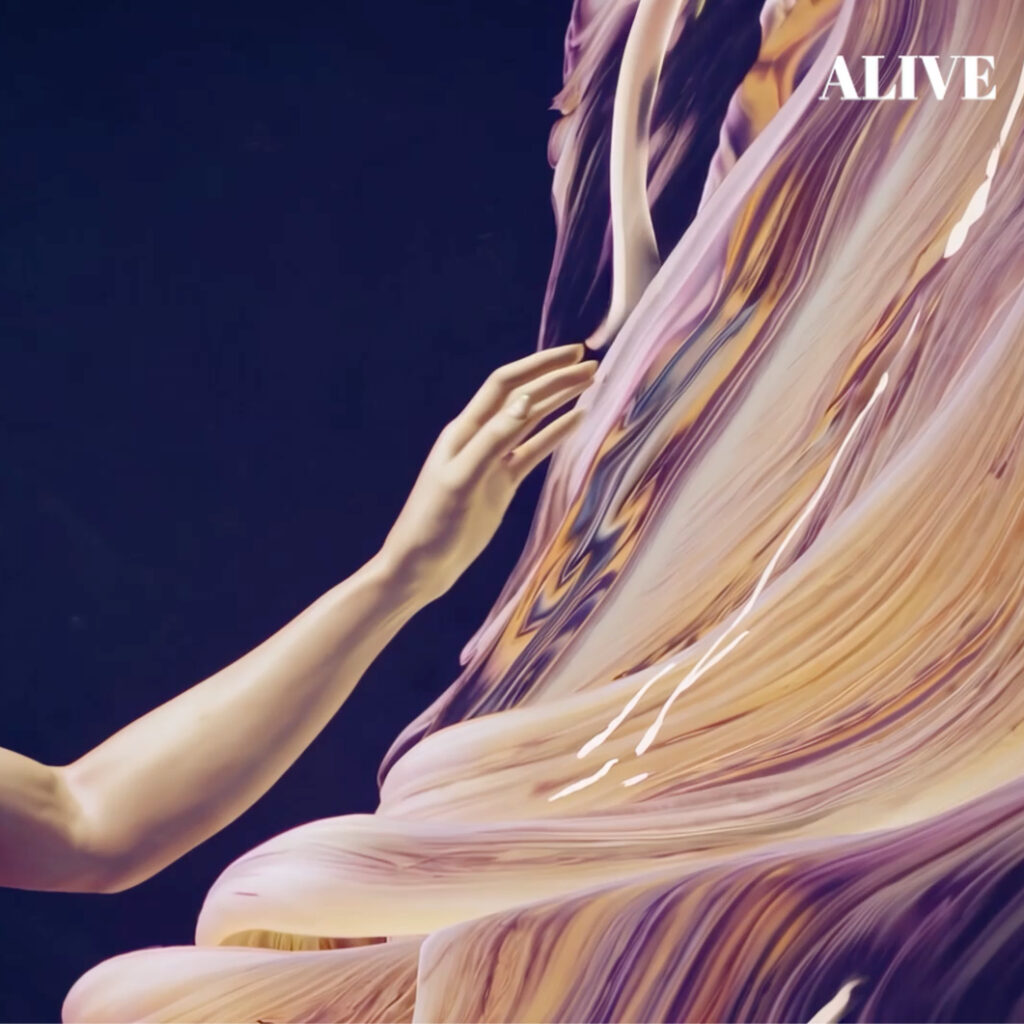
Roope Rainisto:
Touched
(Feat. Elina Ruohonen, Jouna Karsi, Lilli Haapala, Lotta Leka, Sini-Meri Hedberg & Toni Hautamäki)
Roope Rainisto’s short movie ”Touched” is created by extending visual artists works to a parallel world, where the AI reality overlapses with the artist worlds.
The movie and the projects features digitalised works by Elina Ruohonen, Jouna Karsi, Lilli Haapala, Lotta Leka, Sini-Meri Hedberg & Toni Hautamäki, which can be experienced in physical, digital, virtual and AI forms as part of the project. Each of these digital layers open a new perspective on the artworks from physical to digital dimentions.
This production is a collaboration between VAH & The Arts Promotion Centre Finland (Taike) and studies the creative and ethical use of AI as a truly creative tool for the new forms of art.
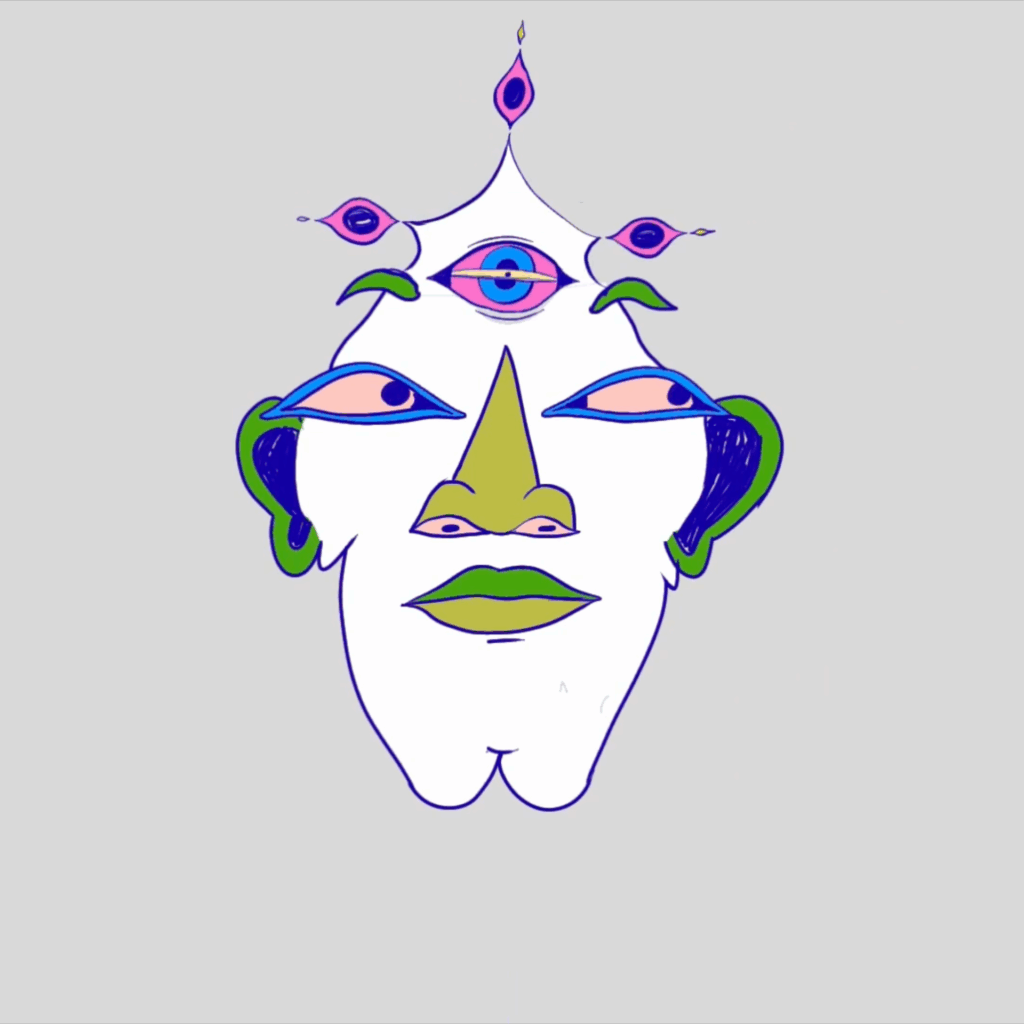
Sahil Betigeri:
Digital (Dis)Embodiments/ Corporal Instruments + Opun Yor Ayes
Corporeal Instruments Artwork Description:
A collection of organic bilateral forms curious to the non-conforming meanderings of the human mind, with the task of imitating nature. Made through a semi-conscious meditation on anatomy, proprioception, and somatization, these instruments are deconstructing and re-coagulating into beings, self-aware and aligned.
Opun Yor Ayes
Stream-of-consciousness, straight-ahead animated short that serves as a visual elucidation of the vijñāna layers of consciousness, emphasizing the fluid and interconnected nature of consciousness.
Through a fragmented narrative shaped by surreal objects, spaces, and anthropomorphic transformations, this experience nudges you to expand and dissolve yourself into a super consciousness by imploring you to open your eyes and then open your eyes beneath them.
The film is divided into 5 subliminal sequences: Birth, Sens, Body, Mind, and Collective.
Birth takes you through the convulsions of this sentient world, familiarising you with the spaces, objects, and characters that will hold you through a journey of awakening.
‘Sens’ draws parallel to the first 4 layers of the vijñāna model (caksur, ghrana srotha, jihva), uncovering the act of sensing (sight, smell, sound, taste) as the most direct form of conscious experience.
‘Body’ equivalent to kaya vijñāna is a subtle exploration of how conscious states manifest physically in our bodies, recognizing our body as a tool with which we engage with this interconnected web of consciousness, fragmented and combined, a vessel for the sound.
Acknowledging biological sentience and genetic consciousness.
‘Mind’ (mano-vijñāna) Mental consciousness, meta-cognition (perceiving your own perception) Dissolving your being into a cerebral space where you watch yourself seed your thoughts and craft your personalized reality ‘Collective’ (alaya-vijñāna) Storehouse consciousness, the collective memories of the world, nature, and its people, becoming unified with a super-consciousness that engulfs everything.
https://www.sahilfromnature.com/
This work is part of the group exhibition Digital (Dis)Embodiments curated by Shashank Satish
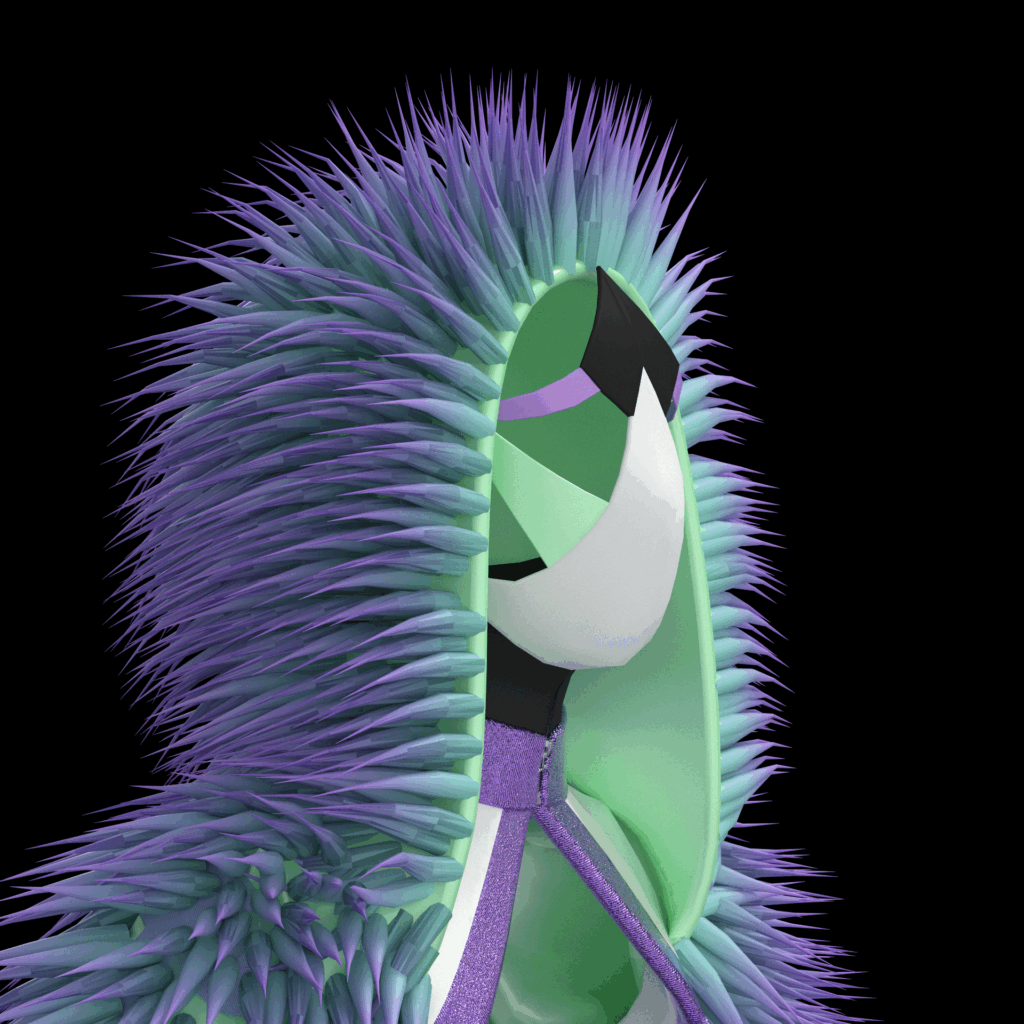
Seamy Side Quest (Jenni Kemppainen & Iida Pitkänen):
Puzzling Side Quest
The puzzling adventure begins with the realization that we are slowly destroying the world we live in.
We always want more; we always want something new. The life cycle of clothing has come faster, and we don’t love our clothes anymore. We need to start thinking about how to re-use the textile materials we already have and make them last longer.
It is a puzzle we need to solve.
(3D garment made with CLO 3D. Digital fashion. 3D model. GLB-file.)

Shashank Satish
Digital (Dis)Embodiments/ Mechanicalized Mindlessness
In Mechanicalized Mindlessness, Shashank explores the concept of power as a dynamic force, passed from person to person and expressed through actions, particularly through the use of human hands. For Shashank, power is never absolute; it is something earned or inherited, always in motion. His work examines how power operates in society and how its expression often becomes mechanical, especially in ritualistic practices.
The piece critiques the ritual of Sandhyavandhanam, a Hindu practice tied to Brahminical traditions and the use of the sacred thread, or Janivara. This ritual, which Shashank grew up performing in his upper-caste Hindu family, involves repetitive hand gestures and body movements that, in his view, are symbolic performances of privilege. These rituals, often practiced without thought, reflect the historical and social power dynamics rooted in caste oppression.
Shashank reflects on his own experience of being required to participate in these rituals, which he came to see as robotic and empty. He eventually rejected this mechanical performativity, choosing instead to question and break away from these traditions. Through the use of 3d-printed plastic, a material that represents artificiality, Shashank externalizes and disembodies these rituals. The repetitive nature of both the 3d printing process and the rituals themselves becomes a metaphor for mindlessness, serving as a critique and rejection of Brahminical privilege.
This work is part of the group exhibition Digital (Dis)Embodiments curated by Shashank Satish
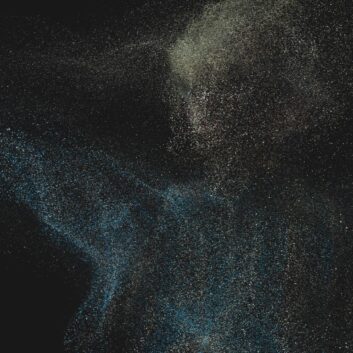
Simone Martinotta :
Shifting Selves
In an increasingly digital Universe, where individual identities are becoming ever more indistinguishable, what role does the individual play in his fictitious uniqueness?
This work seeks to explore the theme of the depersonalization within the virtual world through a particulate graphic component that gradually dissolves, only to reassemble into the essence of the physical body belonging to the tangible everyday dimension.
(Digital art / Live Performance)

Yellow Wasabi:
Goldfish Robot in Bamboo Sea
Goldfish robot in bamboo sea is an immersive audiovisual experience that questions the ecology of life and non-life in the society of digital technology, the last nostalgia before entering the metaverse. The audience will transform into a robot goldfish, carried by the music of the Chinese harp Guzheng, and will swim in the sea of bamboo generated from ancient Chinese Shanshui drawings by AI deepth recognition. Yellow Wasabi will play Guzheng with an atypical sound treatment in MAX/Msp, distorting the timbral and rhythmic structure of the immersive sound continuum. The audience will promenade in this virtual garden and will feel the traditional esthetic of one step on view.
(Unity for computer project)

Yogesh Ramskrishna:
Digital (Dis)Embodiments/ Warriors of a Fallen Kingdom
This series of sculptural characters attempts to define life in the current socio-political conditions of India. Various characters represent the situation, emotion and political impact on the life of locals. Each character is considered an ‘AVATAR’ for survival in today’s Indian society.
Small poems as a title, along with the sculptures, draft the creator’s intention behind building these characters. These words are supposed to help viewers to perceive these characters without identifying the particular gender, cast or place of that character.
(Titles: variable, Medium: PLA (3d printed, Dimensions: variable with fixed height of 11 inches)
https://www.instagram.com/yogesh__ramkrishna
This work is part of the group exhibition Digital (Dis)Embodiments curated by Shashank Satish

You:
VAH Events
Would you like to host your own live event in VAH?
Virtual art House is a socialVR platform where you can host live events, just as real life. You can interact with people (avatars) by talking or moving, share basic file formats from your own files, or stream live video. Options are unlimited from performances to screenings, games or plays, public talks, meetups, discussions, seminars & workshops.
You can create you own way of experiencing and sharing
Fill out the form and reserve your spot (opening soon)
WHAT IS THIS ”EXTRA LIVE” ABOUT?
The partners of the CULTURHUB community created Extra Live during the spring of 2025 by collaborating through virtual residency programs for artists and curators. Extra Live is an expanding event featuring various productions and curated projects, with the initial launch on June 2025.
Extra: Artists and curators explore VAH as another level of existence and reality that is parallel to the physical world. VAH spaces are a combination of large-scale digital replicas of the physical Art House Turku and custom VR spaces and artworks that extend this concept.
Live: In the VAH metaverse, everything happens and is shared with other quests in real time, just like in real life. It is a living digital entity and a SocialVR experience that can be shared by interacting with other quests during random visits, guided tours, artist talks, and live sub-events.
Together, we joined the world-building of the Extra Live event, co-creating something extraordinary for visitors to explore and experience together. Experiencing the world involves negotiating the limits of imagination and sharing perspectives on the world as a shared experience.
We wanted to explore the digital possibilities for all forms of art and culture. One of the questions we wanted to answer is: ”How will art and culture be created in the future, and what will it feel like to experience it?” Read more about the curators’ individual approaches and how they expand the concept of the Extra Live thematically.
Extra Live / Curators words
DIGITAL (DIS)EMBODIMENTS
Curator Shashank Satish
In the digital space, dis-embodiment refers to situations where a person’s identity or presence is no longer tied to a physical body, where traditional understandings of the body are constantly reshaped. This exhibition explores how the human form is rendered, reconstructed, and reconfigured within virtual landscapes, reflecting on the artist’s embodied agency in crafting new digital bodies.
Digital(Dis)embodiments originated as a virtual group exhibition examining the intersection of the body and digitality within contemporary Indian art. In this expanded edition curated by Shashank Satish for the Virtual Art House, the project continues a line of inquiry that began in his earlier work, which focused on disembodiment through Indian philosophical and aesthetic frameworks. Here, the exhibition situates the digital body at the intersection of Eastern and Western worldviews, inviting viewers into a space where embodiment, spirituality, and physicality are continuously negotiated.
This exhibition explores novel convergences of ancient rituals, modern life, and speculative technologies, prompting reflection on enduring questions of existence, transformation, and transcendence. In this space, the human body becomes a construct of consciousness, experienced in the vast terrain of the mind, offering spiritual refuge in a digital world governed by physical laws and algorithmic logic.
The artworks exist in a liminal space—between analog and digital, organic and synthetic, natural and artificial. The exhibition reveals dualities through which the spirit can navigate both tangible and intangible realms. It invites viewers to reflect on the shifting nature of identity in the digital age, where the self is no longer fixed but fluid, adaptive, and continuously reimagined.
Ultimately, Digital(Dis)embodiments offers a speculative portal into the evolving intersections of media, selfhood, and consciousness. It challenges us to reconsider what it means to be embodied in a time when presence can be simulated, multiplied, and transcended. This is an invitation to traverse new terrains of being and becoming within the disembodied realm of the screen.
DOPPELGÄNGER
Curator Yev Kravt
Reflections, Replicas and the Self in the Age of the Digital Double
We live in a time of endless reflection. One body, many selves—physical and digital, authentic and fabricated, curated and corrupted—fractured across timelines, networks and platforms. The notion of the doppelgänger has haunted human consciousness for centuries, surfacing in ancient myth, in psychoanalysis, in cinema, and now in the very devices we keep in our pockets. Today, it is not merely a spectral figure or literary trope; it is a login, a bot, a dataset. A silent algorithmic mirror that watches, predicts and sometimes betrays.
The Doppelgänger exhibition, curated by Yev Kravt, brings together x digital artists, designers, architects and musicians whose practices engage with mirroring and multiplicity. Some approach these themes philosophically, others through a social lens. Some address it performatively, with an air of deliberate deceit. All of those featured here work on the same unsettling question: In a world where everything can be copied, what remains that is still real?
Seeing Double
Throughout history and across cultures, the double has served as both aspiration and threat, representing our hopes as well as our fears. In myth, the twin can take the form of a divine companion—a ghostly spirit, a paranormal appearance or an embodiment of the soul. Though our interest in the double might be ancient, our new reality multiplies the self by design—across social media, virtual worlds and AI-driven platforms.
This exhibition unfolds entirely within a digital copy of the CULTURHUB in Finland, a 3D-rendered replica of the physical space in Turku. Visitors enter through a specially designed virtual pavilion; once nside, an underground corridor reveals artworks that appear familiar—variations on known paintings, sculptures or architectural forms—yet they have all been warped by algorithmic processes and machine learning. AI in many ways is a replica of human behaviour: it trains itself on our images, our words, our ideas and our histories. At its core, it is the ultimate doppelganger of all that has ever existed.
What happens when your reflection no longer reflects you? Can a double outlive the self? And in a world where everything can be copied—what remains real? As we scroll through social feeds, enter dialogue with AI assistants or slip into VR headsets, do we become more connected or more fragmented? Are we glimpsing our future or confronting new shadows? The doppelgänger speaks to the tension between these extremes—between liberating multiplicity and existential dread, between transcendent self-knowledge and inescapable self-deception.
The artists and designers in Doppelgänger. Reflections, Replicas, and the Self in the Age of the Digital Double approach many of the aforementioned questions from every angle; some embrace the beauty of fluid identities, while others reveal the potential dangers of manipulation and echo chambers. The CULTURHUB in Finland becomes a stage where illusions meet realities, leaving visitors to navigate a labyrinth of layered narratives. Through this carefully-choreographed journey, you might just find that the most unsettling reflection is the one that greets you in the mirror each morning.
IT STARTS WITHIN
Curator Virpi Vaittinen (Vivian White):
Connection is often imagined as something external – between people, systems, and structures. Yet every real connection begins elsewhere, in a quieter place: within. It Starts Within explores this hidden starting point, where unseen algorithms, emotional patterns, and layered memories silently shape how we reach toward others.
In a world of shifting truths and multiplying perspectives, misunderstanding is inevitable. To create something new, we must learn to recognise what belongs to us and what belongs to others, and still find ways to meet. The better we understand ourselves, the more fully we can meet others. The depth defines everything.
Presented within a virtual environment, the exhibition makes internal landscapes visible. Through five distinct works, visitors encounter negotiations of care, conversations with the future self, blurred identities, silent spaces, and traces of presence. By stepping into these artist-created worlds, we glimpse parts of ourselves that often remain unseen.
It Starts Within invites a pause – an invitation to reconnect with the inner dimensions that shape how we move through the world.
On the Extra Live
Curator Rebeka Kovács
The digital shift in contemporary art represents more than a technological change — it fundamentally transforms how we perceive, experience, and inhabit artistic environments. Virtual galleries and digital museums do not replace physical spaces but extend them, opening new dimensions of meaning and interpretation. We enter spaces that exist simultaneously nowhere and everywhere, experiencing artworks and narrative environments that would be impossible to encounter otherwise.
Extra Live, hosted by Virtual Art House Turku, operates as a continuum of evolving artistic experiences rather than a traditional exhibition. Within this virtual framework, visitors don’t merely observe artworks: they navigate and inhabit them. When encountering digital installations presented at the Extra Live, viewers can move through layered visual narratives, manipulate temporal sequences, or experience simultaneous multiple perspectives that would be impossible in the physical world. This creates what we might call ”experiential multiplicity”; the ability to encounter the same artwork from radically different vantage points within a single visit.
To curate virtually is to craft presence from potential. The curators become composers of potential encounters, designing interactions where thought, emotion, and code converge to create meaningful immersive experiences inside virtual architectures. Drawing from phenomenological traditions that understand perception as embodied and relational, virtual curation crafts what Merleau-Ponty might recognize as new forms of ”being-in-the-world”, albeit mediated through digital interfaces.
EXTRA LIVE ONLINE EVENTS
Next live events!
(DELAYED) 1/6/2025 Virtual Art House & Extra Live open for public.
- Virtual Art House / Public beta of the platform available
7/6/2025 12:00PM – 13:00 PM (EEST / GMT+3)
- Trans Europe Halles BeHOME conference / Beyond Borders (professional workshop on-site in Sofia, online)
Would you like to host your own live event in VAH?
Virtual Art House is a socialVR platform where you can host live events, just as real life. You can interact with people (avatars) by talking or moving, share basic file formats from your own files, or stream live video. Options are unlimited from performances to screenings, games or plays, public talks, meetups, discussions, seminars & workshops.
You can create you own way of experiencing and sharing
Fill out the form and reserve your spot (opening soon)
VIRTUAL ART HOUSE EXPANSIONS
COLLABORATION & EXTENDED PARTNERSHIPS: ROADMAP FOR THE FUTURE
VAH is about more than just our own curated and customized programs. VAH is a platform that can partner with art and culture professionals, organizations, and institutions. VAH can be utilized and customized for collaborations of any scale, from individual professionals to large networking or organizational partnerships and beyond.
Starting with user-created content, our aim is to allow Art House Turku and Culturhub community partners to create their own unique spaces in the VAH skyscraper’s Infinite Culture Tower (the VAH’s community spaces), with admin tools available in 2026.
Agile forms of collaboration can be simple, fast and straightforward by utilizing VAH’s existing virtual spaces, or they can be time-based, temporary interventions or live events. Scale is not an issue: The platform can enable custom digital or virtual productions, including dedicated virtual spaces of any size. This is ideal for showcasing collections and unique creative projects. Grand designs and strategic partnerships can lead to fully customized virtual environments with an independent content management system and a separate website.
We have a dream, and it’s something we want to share.
Interested? Contact Ville Laaksonen (Coordinator of VAH) for further details.
Follow us on LinkedIn & Instagram
On social media use hashtags
#virtualarthouse #vah #culturhub #extralive #arthouseturku



